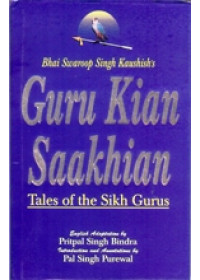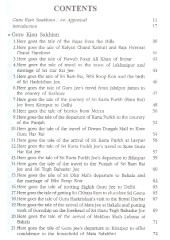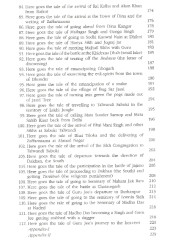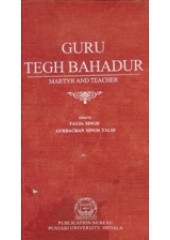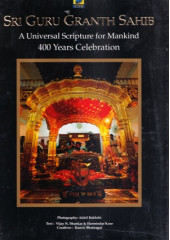Monday to Saturday - 10:00 Am to 9 PM
Now Enjoy Bulk Discounts on Books as Mentioned Below
These Discounts are in addition to the Discounts on Individual Books (Visible as Bulk Discount for Books in Cart)
Extra 10% Off If Books Purchased Exceeds Rs 3000 or 75 USD or 60 GBP or 60 Euro or 100 AUD or 100 CAD
Extra 15% Off If Books Purchased Exceeds Rs 6000 or 150 USD or 120 GBP or 120 Euro or 200 AUD or 200 CAD
Extra 20% Off If Books Purchased Exceeds Rs 15000 or 225 USD or 180 GBP or 180 Euro or 300 AUD or 300 CAD
Extra 25% Off If Books Purchased Exceeds Rs 30000 or 300 USD or 240 GBP or 240 Euro or 400 AUD or 400 CAD
GURU KIAN SAAKHIAN : AN APPRAISAL
Very truly, sources are life and blood for the discipline of history. As a human without oxygen would be lifeless so a historian without sources would be a person without craft. For doing the history of any people availability of sources is a prerequisite. Actually, the nature and quality of the sources as well as their selection and examination determine the quality of the interpretation of a historian. The Sikhs who created history in the north-west of India, have given scant attention to record their annals. Almost all the historians working on the history of the Sikhs, have always felt the scarcity of source material. What has been written either belongs to the category of hagiography or has come out of the pen of outsiders. Sometimes these chronicles lack in objectivity and neutrality, the two most sought after principles for doing the history. Occasionally, these sources instead of supplementing each other provide divergent account which at times is hardly to reconcile.
Search for new source material is a fascinating as well as challenging task. In fact utility and authenticity of a new source largely depends upon the integrity and skills of a historian introducing it. It needs much experimentation and testing to establish its historical value. Guru Kian Saakhian which surfaced in 1970s and has been used very enthusiastically by some scholars is such a source of Sikh history which has never been subjected to rigorous methodology to test its authenticity. Professional historians are still skeptic about its origin. Thus its fate as a genuine source or vice-versa is hanging in the air.
According to the colophon at the end, it was completed in 1790 (1847Bk.) at Bhadson near Thanesar now in the present state of Haryana. Though, the name of its author is missing in the colophon yet its authorship is attributed to Swaroop Singh Kaushish. It is said he was a Bhatt, a minor or sub-section of priestly class living on alms. The Bhatts who were some sort of bards besides keeping the geneology of their clients oftenly dabbled in poetics to eulogise them. Traditionally, they used to visit their clients at the end of a season and recorded birth, death or any other important event in their Vahis. Guru Kian Saakhian is said to be largely based on the Bhatt Vahis which its author has got from his ancestors. Originally, he wrote it in Bhattakhri, a peculiar from of Devanagari without vowel symbols. In 1868 Chhajju Singh, a descendant of the author converted it into Gurmukhi. However, its original in Bhattakhri and its second version in Gurmukhi are no more extant, which puts a big question mark on the very origin of this document. The present version in circulation is a copy which Giani Garja Singh has made from another copy which was in possession of Sant Gurdit Singh of village Dabwali Malko Ki, near Malout. The published version is based on the copy edited by Giani Garja Singh, which in turn has again been revised and re-edited by Piara Singh Padam in 1986.
Bhatt Vahis came to light in 1960s and credit for it goes to Giani Garja Singh who had done a pioneering work in this field. After him Giani Gurdit Singh, Dr. Fauja Singh etc. have used this category of source material for historical write-ups. These scholars trace the descent of the author of Guru Kian Saakhian back to the Bhatts associated with the Sikh Gurus whose writings are well-preserved in the Sikh scripture. Keeping in mind the significance of this newly found source of Bhatt Vahis, the Department of Guru Nanak Studies, Guru Nanak Dev University, Amritsar way back in 1978 has initiated a research project on the Bhatt and Panda Vahis. At that time the author of these lines was entrusted with the task to locate the Bhatts and their Vahis in question. On the basis of leads provided by Giani Garja Singh in his writings especially Shahid Bilas Bhai Mani Singh (1961), we were able to establish contact with the Bhatts residing at Banbhauri (Distt. Hisar), Karsindhu (Distt. Jind) and Bhadson (near Kurukshetra). We observed that though some of them possessed Vahis but most of them were Jangams, a Saivite sect living on alms. On examination of their Vahis we found that their accounts relate to the Wanjaras of Malwa and Khamdesh of central India. Barring one example all of them were clean shaven and frequently smoke tabacco. By faith every inch they were Hindus and had nothing to do with Sikhism. (Balwant Singh Dhillon, "Bhatt Vahian : Tath Te Kath", Punjab History Conference, 23rd Session, Panjabi Section, March 17-19, 1989, Panjabi University, Patiala, pp. 54-60).
Guru Kian Saakhian comprises 112 anecdotes (sakhis) in all. Of these Sakhi No. 1-4 relate to Guru Hargobind, No. 5-14 deal with the life of Guru Har Rai, No. 15-18 concern with Guru Har Krishan, No. 19-33 are devoted to the life of Guru Tegh Bahadur and No. 34, 35 and 36 are associated with Dhir Ma, Ram Chand and Bhar Mal respectively. The major Chunk No. 37-112 describe important events related to the life of Guru Gobind Singh. The little seems to be quite misnomer as it does not include any anecdote relating to the first five Sikh Gurus. It starts in an abrupt manner with the activities of Guru Hargobind in and around Kiratpur. Though, it is said to be an independent attempt which is largely based on the Bhatt Vahis, but a close look at the sakhis confirms that its author has drawn heavily from Mahima Parkash by Sarup Das Bhalla, Parchian Sewa Das, Malwa Des Ratan Ki Sakhi Pothi and some other sources as well. The style employed does not fit well into the prevalent category of Janamsakhi or Goshti literature. Similarity, the language is a mixture of Punjabi and Hindustani prose. The thrust is on narrative which falls in the category of hagiography. Significantly, it provides dates of the events which are very unique. It offers 'a feast of dates' to an historian working on the history of the Sikh Gurus.
On examination we find that authenticity of the narrative and accuracy of the dates are two major problems that come in the way of Guru Kian Saakhian as an incredible source. For example Guru Har Rai's Travel in Jammu and Kashmir (Sakhi # 6), Ram Rai's role after his expulsion from the Panth (Sakhi # 11-13, 39-41), Guru Tegh Bahadur's visit to Patna in 1656 (Sakhi # 14), Harji's cordiality towards Guru Tegh Bahadur (Sakhi # 21), Guru Gobind Singh's sojourn in Jammu-Kashmir and Lakhi Jungle in the year of 1692 (Sakhi # 50-51), Creation of Khalsa in 1698 (Sakhi # 58) and marriage of Sahibzada Ajit Singh in 1704 (Sakhi # 76) are some of the events which are not corroborated by any other source. Secondly, the nature of description of the events is quite contrary to the Sikh tradition in current. Thirdly, no relic or place sanctified by Guru Gobind Singh has been noticed so far in Jammu and Kashmir.
The author of Guru Kian Saakhian makes us to believe that in 1656 Guru Tegh Bahadur before assuming Guruship had been to Bihar and Assam and Guru Gobind Singh took birth at Patna in December 1661 (Sakhi # 14). On the other hand a Hukamnama of GuruTegh Bahadur addressed to the Sangat of Patna makes reference to his sojourn in Assam in the company of a Raja (Ganda Singh, Hukamname, p. 87). A news of Imperial letter, Akhbarat-i-Darbar-i-Muala (May 13, 1710) confirms that Guru Tegh Bahadur was in the company of Raja Ram Singh of Jaipur during his expedition to Assam. (Ganda Singh ed., Makhiz-i-Tawarikh-i-Sikhan, p. 83). Another Hukamnama of Guru Tegh Bahadur refers to the birth of Guru Gobind Singh at Patna (Hukamname, p. 103). Similarly, in another Hukamnama (p. 107) Guru appreciates the Sikh Sangat of Patna for looking after the child Gobind Das and family of the Gurus. These Hukamnamas bear testimony to the fact that these were written when Guru Tegh Bahadur was not an ordinary person but had assumed Guruship of the Panth in its full sense. Thus, the above information of Guru Kian Saakhian stands confronted by the other reliable sources.
Like Guru Kian Saakhian an entry of Bhatt Vahi Poorbi Dakhni also refers to Guru Gobind Singh's birth in 1661 at Patna (Piara Singh Padam, Guru Kian Saakhian, pp. 15-16). However, the entry in question is very interesting and worth-noting. It makes reference to Guru Tegh Bahadur as the Ninth Guru whereas at that time (December 1661) instead of him Guru Har Krishan was holding the mantle of Guruship. The same entry describes the city of Patna on the banks of Jamuna. It proves that the author of Guru Kian Saakhian was not well-versed with the topography surrounding the city of Patna. All these factors coupled with internal contradictions jeopardise the authenticity of Guru Kian Saakhian. Pal Singh Purewal, an established almanac expert has very laboriously checked the correctness of dates mentioned in it. He has come across certain instances of internal conflict between the elements of dates. In his opinion such dates instead of coming from reliable source, are calculated or concocted ones.
In some cases information provided by the author of Guru Kian Saakhian is very unique and has come to us for the first time. For example code of conduct of the Khalsa (Sakhi # 59-60), investiture of the Adi Granth with Guruship by Guru Gobind Singh (Sakhi # 112) etc. present graphic accounts which are not available anywhere else. These factors enhance the value of Guru Kian Saakhian as a historical source. It compels us to take notice of it very seriously. To recapitulate, we can say that instead of relying on its face value, judicious, cautious and selective use of Guru Kian Saakhian can be of immense value to fill up the gaps in the history of the Sikh Gurus. S. Pritpal Singh Bindra, a well-known educationist and literary figure based in Toronto, Canada deserves our accolades for introducing this source to the English knowing people. He has understood the text well and has remained very close to the original to keep its spirit intact. Introduction with copious notes and references by Pal Singh Purewal serve the purpose of corrective as well as judge the veracity of the events. English knowing readers will find this volume quite interesting and helpful to understand various facets of the literature associated with Sikhism.
| January 24, 2005 | Dr. Balwant Singh Dhillon |
| Head, Deptt. of Guru Nanak Studies, | |
| Guru Nanak Dev University, | |
| Amritsar. |
From the frontcover of the Book 'Guru Kian Saakhian - Tales of Sikh Gurus' By Bhai Swaroop Singh Kaushish
Guru Kian Saakhian by Bhai Swaroop Singh Kaushish is an important source on the lives of the Sikh Gurus, believed to be written on the basis of Bhatt Vahis in 1790 A.D. It comprises of 112 Sakhis related to the life-stories of Guru Hargobind Sahib to Guru Gobind Singh. It provides dates of the events which are very unique and in some cases the information has come to us for the first time.
The present work is an English translation of this important source book. Pal Singh Purewal, an established almanac experts has very laboriously checked the correctness of dates mentioned in it. His scholarly introduction with copious notes and references serves the purpose of corrective as well as to judge the veracity of the events.
About the Author 'Pritpal Singh Bindra' of the Book 'Guru Kian Saakhian - Tales of Sikh Gurus
Pritpal Singh Bindra, born in 1929 at Lahore, did post-graduation in teaching at Khalsa College, Amritsar. He moved to U.K. in 1960 after teaching a few schools in India. He taught in London for two years and thereafter, went into his own insurance business. He sold his business in 1983 and exclusively engaged himself in Sikh Studies. His works Thus Sayeth Gurbani, Charitro Pakhyaan and Kalaam-e-Goya Bhai Nand Lal have been well received. He has also more than 100 articles on Sikh Studies to his credit.
Table of Contents of the Book 'Guru Kian Saakhian - Tales of Sikh Gurus' By Bhai Swaroop Singh Kaushish
| CONTENTS | ||
| Guru Kian Saakhian : An Appraisal | 11 | |
| Introduction | 17 | |
| Guru Kian Sakhian | ||
| 1. | Here goes the tale of the Rajas from the Hills | 39 |
| 2. | Here goes the tale of Kalyan Chand Kahluri and Raja Himmat Chand Handoori | 41 |
| 3. | Here goes the tale of Nawab Nasir Ali Khan of Ropar | 42 |
| 4. | Here goes the tale of travel to the town of Lakhmipur and marriage of Sri Har Rai Jee. | 44 |
| 5. | Here goes the tale of Sri Ram Rai, Bibi Roop Koir and the birth of Sri Harkrishan Jee. | 46 |
| 6. | Here goes the tale of Guru Jee's travel from Jalalpur Jattan to the country of Kashmir | 47 |
| 7. | Here goes the tale of the journey of Sri Karta Purkh (Ram Rai) Jee from Kiratpur to Delhi | 48 |
| 8. | Here goes the tale of berries from Mecca | 50 |
| 9. | Here goes the tale of the departure of Karta Purkh to the country of the Punjab | 52 |
| 10. | Here goes the tale of the travel of Diwan Durgah Mall to Kote Guru Har Rai | 54 |
| 11. | Here goes the tale of the arrival of Sri Karta Purkh at Lavpur | 56 |
| 12. | Here goes the tale of Sri Karta Purkh Jee's travel to Kote Guru Har Rai Jee | 57 |
| 13. | Here goes the tale of Sri Karta Purkh Jee's departure to Bilaspur | 59 |
| 14. | Here goes the tale of the travel to the Punjab of Sri Ram Rai Jee and Sri Ram Rai Jee and Sri Tegh Bahadur Jee | 60 |
| 15. | Here goes the tale of Sri Dhir Mal's departure to Bakala and the marriage of Bibi Roop Koir | 62 |
| 16. | Here goes the tale of inviting Eighth Guru Jee to Delhi | 63 |
| 17. | Here goes the tale of getting Sri Chhaju Ram to elucidate Sri Geeta | 65 |
| 18. | Here goes the tale of Guru Harkrishan's visit to the Royal Darbar | 67 |
| 19. | Here goes the tale of the arrival of Mata Jee at Bakala and putting mark of Guruship on the forehead of Sri Guru Tegh Bahadur Jee | 69 |
| 20. | Here goes the tale of the arrival of Makhan Shah Lubana at Bakala | 71 |
| 21. | Here goes the tale of Guru Jee's departure to Kiratpur to offer condolence to the household of Mata Sulakhni | 72 |
| 22. | Here goes the tale of getting a pool built at Talwandi and of going to Dhamdhan | 73 |
| 23. | Here goes the tale of Bhai Sangtia and Bhai Ram Dev | 74 |
| 24. | Here goes the tale of going to Bilaspur (at the Seventeenthday Service) of Raja Deep Chand | 76 |
| 25. | Here goes the tale of travel from Dhamdhan to Delhi | 78 |
| 26. | Here goes the tale of travel from Assam to Delhi and the country of Punjab | 81 |
| 27. | Here goes the tale of going to Chak Nanki | 82 |
| 28. | Here goes the tale of Brahmins (Hindu Priests) of Kashmir coming to Chak Nanki | 83 |
| 29. | Here goes the tale of Guru Jee's appearance, alongwith three Sikhs, before Delhi's Suba (the administrator) at Sirhind | 85 |
| 30. | Here goes the tale of martyrdom of three Sikhs of Guru Jee |
| Books | |
| Author | Bhai Swaroop Singh |
| Pages | 230 |
| Cover | Hardbound |
| Language | English |
Guru Kian Sakhian - Tales of sikh Gurus - Book By Swarup Singh Koshish
- Brand: Singh Brothers
- Product Code: SGE132
- Availability: In Stock
-
Rs.350.00
Related Products
Sikh Shrines in Delhi - Book By Amrik Singh
From the Backcover of 'Sikh Shrines in Delhi' By Amrik Singh Though Sikhs are mainly concentr..
Rs.375.00
The Essence of Sikhism - Lives and Teachings of Sikh Gurus - Set of 8 Books - Book By Tejinder Kaur Anand
Table of Contents of the Book 'The Essence of Sikhism -1' By Tejinder Kaur Anand ..
Rs.569.00
Guru Kian Sakhian - Book By Piara Singh Padam
Guru Kian Sakhian -Book By Piara Singh Padam ..
Rs.200.00
Guru Tegh Bahadur - Martyr and Teacher - Book By Fauja Singh , Gurbachan Singh Talib
Introduction to the Book of 'Guru Tegh Bahadur - Martyr And Teacher' By Fauja Singh, Gurbachan..
Rs.120.00
Hukamnamas - Sri Guru Tegh Bahadur Ji - Punjabi - Hindi - English - Book By Fauja Singh
Foreword To 'Hukamnamas - Sri Guru Tegh Bahadur Ji - Punjabi - Hindi - English' By Fauja Singh..
Rs.150.00
Life Story of Sri Guru Tegh Bahadur Ji - Book By Harbans Singh Doabia
From The Back Cover Of 'Life Story of Sri Guru Tegh Bahadur Ji' By Harbans Singh Doabia 1. Guru T..
Rs.30.00
Sri Guru Granth Sahib - Book By Vijay N. Shankar & Harmindar Kaur
From The Back Cover Of 'Sri Guru Granth Sahib' By Vijay N. Shankar & Harmindar Kaur Sri Guru ..
Rs.2,895.00
Tags: books guru gobind singh, books on sikh gurus, books on teachings of guru nanak, sakhis of sikh gurus, teachings of guru gobind singh, teachings of sikh gurus kian, sakhian, tales, swarup, koshish, english

